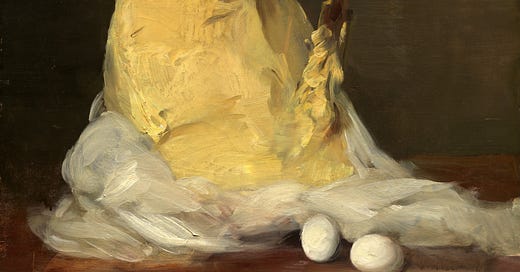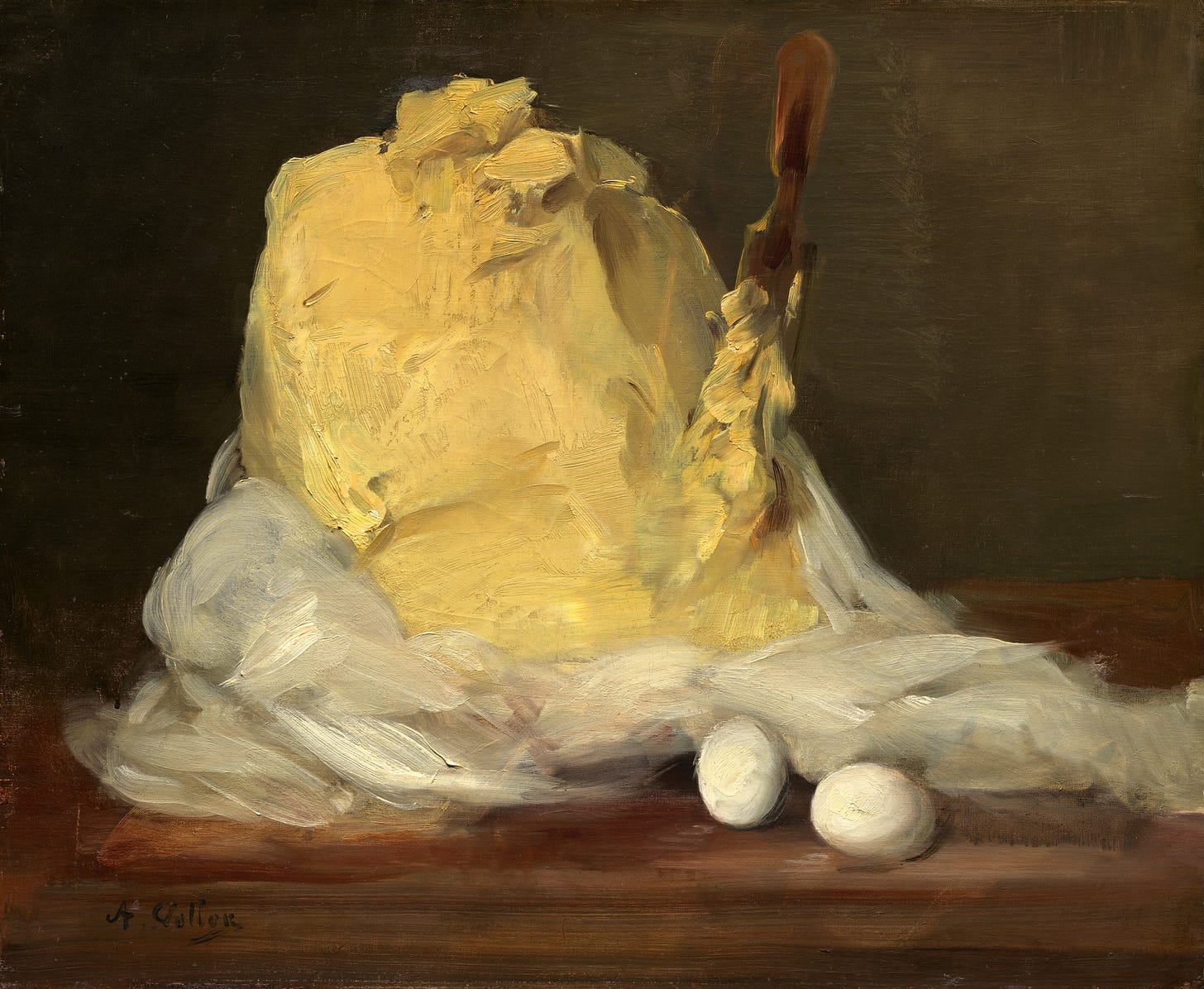Hello old and new subscribers—welcome! If you like this newsletter, follow 💌shelfoffering on Instagram and please share with a friend or two.
I used to have a recurring dream, when I was much younger, about a bright orange plastic mould that would churn out perfect shapes of dough in tiny screws falling straight into hot oil and dissolving smoothly, as if nothing had gone into the oil in the first place. The ‘dough’ I dreamed about was a huge chunk of yellow butter. That huge chunk remained in my consciousness for a long time after that. I was, and still am, truly obsessed with butter. I’d secretly cut up tiny slivers whenever my grandmother wasn’t looking and swallow them whole. If my mother was around, she’d give me tiny cubes of salted butter which I’d place on my tongue and revel in the unctuousness, in the stillness, in how my tongue would readily melt the ice cold piece of butter taken straight from the freezer. The alchemy was endlessly fascinating.
Nothing has jogged back that memory quite like Antoine Vollon’s ‘Mound of Butter’ — which, no surprise, I consider to be one of the sexiest paintings ever. That lusciousness, only achieved by a thick impasto, is very convincing. Vollon, a realist, worked with oils but somehow it feels as if he grabbed a huge mound of actual butter and churned it on the canvas, draped a thin cheesecloth around it, and barely placed two eggs on a table. I’ve written a bit about Wayne Thiebaud’s technique previously, noting his use of heavy pigment, exaggerated colours, and a singular obsession with objects of mass culture. I’m certainly no expert at interpreting art, and maybe no one can be because it is so personal and peculiar, but it is transitory. And by definition, transitory things have little time, even if they persist. Which is why I think when it comes to food and art, one must persist and live, study and derive pleasure as much as possible.
So Vollon’s ‘Mound of Butter’ deserves more than a temporary glance. In the last two years, I have looked at it countless times, made it my screensaver, and tried recreating it using oil pastel crayons. I am hopeless of course, so I gave into the scrutiny and followed the interpretation. Vollon’s use of oils helps reveal the unctuousness of butter, the depth and the luminosity of its buttercup brilliance. What I’ve learnt is that oils are an act of penance. Oils let you take the time to revisit and correct, and to come back and pick up from where you left off. That watercolours are more forgiving but for the medium to be merciful, it requires the act of letting go. You can keep coming back to oils if you are patient; if you’re impatient you can look toward watercolours.
But of course nothing is permanent.
Qualities of real butter seem pasted on the canvas — I keep coming back to the idea that at some point Vollon might have used his fingers to smear the yellow in some places (unsubstantiated but firm belief!), especially in the area opposite to the wooden paddle that features some streaks. Thick streaks! How is this not butter? So creamy and abundant, and so simple. The latter especially is a stark contrast as still life paintings in the late 19th century have been elaborate, featuring bright flowers and bourgeois households, fruits, bread, silver knives, and cheese. For a long time, I thought still life was a perfunctory practice of documenting everyday rituals. I’ve changed my mind, now noting that it’s still about life but celebrating life’s ephemerality in all its joys and sorrows: whether colourful dahlias, poppies, and carnations; fresh bread and wheels of gouda; or fresh butter, they all have an expiration date. Therein lies the materiality of paint in bringing this context to life — the butter here is unctuous and oily, physically present and enduring.
In reality, a block of butter1 won’t last as long.
Marni Kessler writes about this in detail in Discomfort Food, about the immaterial possibilities that belie the banal subjects contained in still life. Vollon’s butter painting evokes a natural gustatory pleasure to the onlooker (butter so sexy!), but Kessler breaks this narrative and roots them in the histories of their time. For example, this delicious butter is presumed to obtain its yellow auspiciousness from the carotene of the plants that cows graze on. But Kessler writes that it was more likely to be adulterated. Today, butter is standardly yellow, signalling the presence of annatto that is added to trick our brain into thinking it’s more delicious than it sometimes is. It’s wrapped in delicate cheesecloth because freshly made butter is wrapped to remove excess liquid (buttermilk mixed with water that the butter is usually washed in). And the eggs are placed at the forefront to depict the enormousness of the butter. But that’s not all.
Both the eggs and the butter represent a vulnerability. The eggs because they’re delicate and are placed so close to the edge of the table. The butter because it spoils quickly; a bulk of it can go rotten and melt in minutes. The swaddling cheesecloth only adds to the uneasiness, resembling giant waves frothing and crashing that signify impending doom. Perhaps the more it is out in the open, the more there is a chance of the wooden paddle losing its footing in the softening butter, as the paddle can easily knock both the eggs away. Something so enticing and lavish could also have a quality of dismay. Vollon was the first to depict butter in such a defenceless state. Before him it was Clara Peeters, the Flemish still life painter whose work I’d love to study in another newsletter, and her obsession with depicting the traditions of the Netherlandish ontbijtjes (or breakfasts). Her work featured curls of butter often in a porcelain or a metal dish perched on top of bread and giant wheels of cheese highlighting the ingredient’s humble and everyday origins.
‘Mound of Butter’ is larger than life.
A hundred and so years before Vollon painted this masterpiece, students at Harvard recorded their first protest: against butter. This was in 1766, a decade before the American Revolution, when the quality of fresh food was declining and students’ complaints, as always, were disregarded. The protest was led by seniors, but it was Henry David Thoreau’s grandfather, Asa Dunbar, who was first to the uprising by proclaiming: “Behold, our butter stinketh!—Give us, therefore, butter that stinketh not.” Dunbar, who was punished for insubordination, found himself the hero of the moment, and fellow students accepted it as their motto. The Great Butter Rebellion was both a battle for better butter and for future demonstrations2 — culinary or not.
Perhaps Vollon subconsciously incorporated this larger-than-life quality into his painting — butter as a bounty. And perhaps Kessler traces an unsettling notion of rancidity and anxiety back to the rebellion, because she writes that “the sheer magnitude of the contents of Mound of Butter seems a bit ungraspable”. I also think the inherent problem with scale of ingredients is that there is no universal standard, especially within cultures that tend to see abundance as excess. A brick of butter may seem perverse but the imposing structure represents the validity of butter and its reverence in cooking.
But this anxiety can also be seen in a different way: whose labour (often gendered) has been mobilised to produce this dairy product? And who consumed it? The discomfort also comes from looking at whose voices have been marginalised in art. Butter was the focus of this painting possibly because it was in such high demand in the late 19th century. So French emperor Napoleon issued a challenge to help create a cheaper butter substitute (from beef tallow) for the lower classes and the military so the rich could enjoy a mound of butter unbothered. This challenge gave rise to margarine, which saw little success in France. Butter became a signifier for both anxiety and prosperity, both beauty and disgust.
While looking for butter-adjacent things, I came across Melati Suryodarmo’s performance piece, ‘Exergie - Butter Dance’ where the artist dances on heaps of butter: she repeatedly slips and stumbles and explores the bodily sensation experienced in the single delicate moment where the body loses control before falling over. The dance conveys pain as a universal human experience, the importance of human will and determination in life. It is difficult not to cringe at several moments when she falls, but falling is inevitable. The dancer knows this, the viewer knows this. But I also think that she falls on purpose, and steadfastly picks herself up after every fall. What this informs me is that both butter and life are ephemeral. They’re raw, exposed, and vulnerable at any given moment. They promise both pleasure and discomfort. But one does not have to mean the absence of the other — both butter and life contain multitudes.
Historically, butter has been salted to preserve it rather than matters of taste, because lack of refrigeration turned unsalted fresh butter rancid, which meant that France's less salted, unpreservable butter became a delicacy throughout the world, and especially when the US emulated French cuisine.
The French Revolution happened a few years after the Butter Rebellion, which can be traced to salted butter. First imposed in the mid 14th century, the gabelle was an unpopular salt tax in France that lasted well into the 20th century. Originally a tax on spices, wine, and other agricultural commodities, it was limited to salt from the 14th century and caused high disparities among regions in France and ultimately became a hated form of revenue generation till it indirectly led to the French Revolution.






oh this was incredible
Such a fabulous essay! Also made me think about the book Woman,Eating by Claire Kohda - you may like it! It explores art and food interactions through a hungry young vampire (but it’s not Twilighty haha, more A Girl Walks Home Alone at Night)